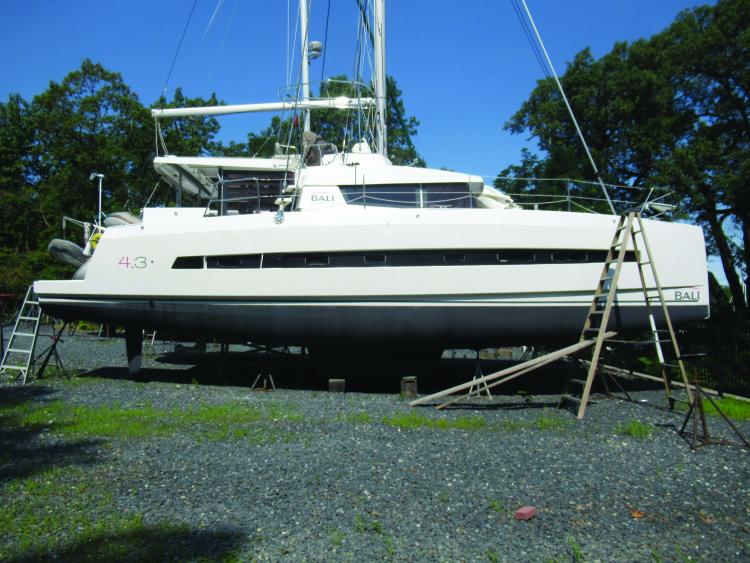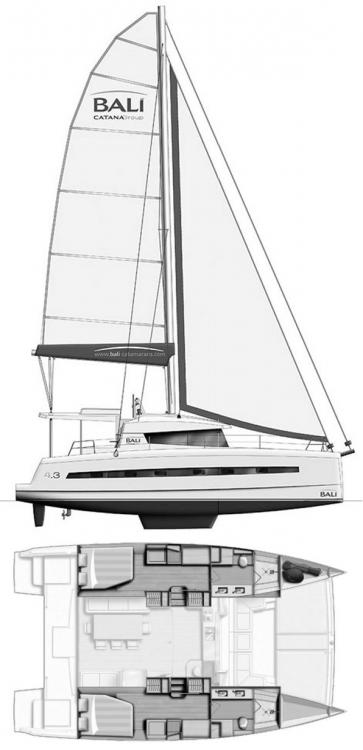A Competitively Priced Cruising Catamaran: the Bali 4.3
To anyone trying to buy a boat since the pandemic began, it may have become obvious that the marine market in general has been red hot and has been since April/May of 2020. Prior to 2020, the industry was strong, with some sections of the market underperforming, especially older sailboat design monohull heavy-displacement cruisers. Catamaran sales have been strong for the last several years.

When Hurricane Irma hit the British Virgin Islands, a large percentage of the catamaran charter fleet was destroyed. Rebuilding this fleet made for longer-than-average waitlists for new builds, making late model used boats a hot commodity. Combine that with the boat demand created by Covid; the average sale of almost any boat now is at least 20 percent higher than it would have been in early 2020. Clean, quality boats regardless of age rarely stay on the market more than a couple of days.
Bali, a brief history
The Bali catamaran line was introduced in 2014 by the French catamaran builder Catana and is built at the Catana factory in France. Catana has a long history of building catamarans, but until the introduction of the Bali line, the focus at Catana was concentrated on building more performance-oriented designs. The Bali concept was to provide catamarans that were more cruising oriented while remaining competitively priced; this also seems to have included the interests of the charter industry. As a result of this shift, the Bali catamaran line quickly grew in popularity and has been embraced by both private owners and you guessed it, the charter industry.
Bali 4.3
At first glance the Bali 4.3 does not look much different than many other modern cruising catamarans. Catamarans in general have recently taken on a more angular appearance with noticeably higher profiles. A closer look reveals some obvious construction and design innovations. The Bali 4.3 does not have a traditional webbing “trampoline” foredeck that is common on other cats. The Bali foredeck area is integral with the deck mold, eliminating the trampoline, vulnerable aluminum cross beams, and associated rigging. This results in a more ridged structure, reportedly lighter weight forward and more buoyancy. Draining the foredeck area is accomplished with three large scuppers.

Also incorporated into the deck structure are molded seats. Another distinct design innovation is the aft cockpit/saloon interface that incorporates what has been affectionately referred to as a “garage door.” The entire back wall of the main cabin will roll up, much like a standard garage door, making the saloon, galley, and aft deck a single interconnected area. The aft/garage wall, when down, has a weather-tight door for use during inclement weather and passages.
Construction methods and materials have been upgraded; hulls and decks are resin-infused with closed cell PVC foam. The use of foam/nonorganic core is significant. As any cored boat ages, deck fittings, thru-hulls, and minor dings in the hull exterior will let moisture enter through the outer fiberglass skin into the core. Closed cell foam will not absorb moisture and is much slower to degrade if subjected to prolonged exposure to water; this is critical to maintaining structural integrity of hull and deck structures over time.
- Auxiliary power is provided by Volvo D2 4-cylinder diesel engines connected to Volvo Sail Drives, and the generator is a Northern Lights; both brands are considered industry standards and reliable with good service histories and support.
- Curiously the last Bali I inspected did not appear to have a molded or aftermarket rub rail, leaving the hull more vulnerable to gelcoat dings from pilings, docks, and other boats.
- The davit assembly could have been better engineered and built; I noted some rather crude welding on davit hardware. This may have been an aftermarket repair.
- The upper helm/fly bridge is high and exposed. There is precious little protection from the elements provided to the helm by the builder. The entire cabin profile is elevated pushing everything up, resulting in a significantly higher boom, making access to the sail and sail bag difficult.
- Although purportedly designed for cruisers, the saloon table size combined with the garage door concept makes for an enormous entertainment area which should be a very popular feature with the charter crowd.
- My personal experience regarding the sailing characteristics is limited. Reports from the field seem to indicate that the Catana performance legacy is shared with the Bali 4.3.
- As I went through bilges and lockers, the overall build quality seemed above average; resin infusion of hulls and decks eliminated gelcoat and laminate voids.
- The steering gear should be monitored annually; notable wear was found in the steering linkage.
- The saloon/cockpit interface is, in my opinion, borderline genius, with an incredible amount of open-air space available with the “garage door” up. The model I last inspected was three years old, and the function and condition of the door seemed like new. I would love to test this system again in five years.
As of September 2021, there were three Bali 4.3s on the market in the United States including the U.S. Virgin Islands. Prices were narrowly spaced between $550,000 and $560,000.
About the Author: Capt Tarn Kelsey owns and operates Kelsey Marine Survey in Annapolis.




